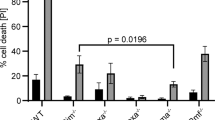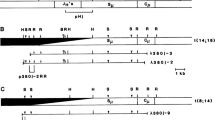Abstract
Mast cells play critical roles in the regulation of acute and chronic inflammations. Apoptosis is one of the mechanisms that limit and resolve inflammatory responses. Mast cell survival can be controlled by growth factors and activation of the IgE-receptor FcɛRI. Members of the Bcl-2 protein family are critical regulators of apoptosis and our study provides evidence that the proapoptotic BH3-only family member Bim is essential for growth factor deprivation-induced mast cell apoptosis and that Bim levels increase upon FcɛRI activation. Bim deficiency or Bcl-2 overexpression delayed or even prevented cytokine withdrawal-induced mast cell apoptosis in culture. The prosurvival protein Bcl-XL and the proapoptotic Bim were both induced upon FcɛRI activation. These results suggest that Bim and possibly also other BH3-only proteins control growth factor withdrawal-induced mast cell apoptosis and that the fate of mast cells upon FcɛRI activation depends on the relative levels of pro- and antiapoptotic Bcl-2 family members.
Similar content being viewed by others
Log in or create a free account to read this content
Gain free access to this article, as well as selected content from this journal and more on nature.com
or
Abbreviations
- BH:
-
Bcl-2 homology
- BMMC:
-
bone marrow-derived mast cell
- SCF:
-
stem cell factor
References
Wedemeyer J, Tsai M and Galli SJ (2000) Roles of mast cells and basophils in innate and acquired immunity. Curr. Opin. Immunol. 12: 624–631
Benoist C and Mathis D (2002) Mast cells in autoimmune disease. Nature 420: 875–878
Viegas M, Gomez E, Brooks J and Davies RJ (1987) Changes in nasal mast cell numbers in and out of the pollen season. Int. Arch. Allergy. Appl. Immunol. 82: 275–276
Gibson PG, Allen CJ, Yang JP, Wong BJ, Dolovich J, Denburg J and Hargreave FE (1993) Intraepithelial mast cells in allergic and nonallergic asthma. Assessment using bronchial brushings. Am. Rev. Resp. Dis. 148: 80–86
Godfrey HP, Ilardi C, Engber W and Graziano FM (1984) Quantitation of human synovial mast cells in rheumatoid arthritis and other rheumatic diseases. Arthritis Rheum. 27: 852–856
Strasser A, Harris AW, Huang DC, Krammer PH and Cory S (1995) Bcl-2 and Fas/APO-1 regulate distinct pathways to lymphocyte apoptosis. EMBO J. 14: 6136–6147
Marsden VS and Strasser A (2003) Control of apoptosis in the immune system: Bcl-2, BH3-only proteins and more. Annu. Rev. Immunol. 21: 71–105
Huang DC and Strasser A (2000) BH3-only proteins – essential initiators of apoptotic cell death. Cell 103: 839–842
Zong WX, Lindsten T, Ross AJ, MacGregor GR and Thompson CB (2001) BH3-only proteins that bind pro-survival Bcl-2 family members fail to induce apoptosis in the absence of Bax and Bak. Genes Dev. 15: 1481–1486
Cheng EH, Wei MC, Weiler S, Flavell RA, Mak TW, Lindsten T and Korsmeyer SJ (2001) BCL-2, BCL-X(L) sequester BH3 domain-only molecules preventing BAX- and BAK-mediated mitochondrial apoptosis. Mol. Cell 8: 705–711
Cervero C, Escribano L, San Miguel JF, Diaz-Agustin B, Bravo P, Villarrubia J, Garcia-Sanz R, Velasco JL, Herrera P, Vargas M, Gonzalez M, Navarro JL and Orfao A (1999) Expression of Bcl-2 by human bone marrow mast cells and its overexpression in mast cell leukemia. Am. J. Hematol. 60: 191–195
Yeatman II CF, Jacobs-Helber SM, Mirmonsef P, Gillespie SR, Bouton LA, Collins HA, Sawyer ST, Shelburne CP and Ryan JJ (2000) Combined stimulation with the T helper cell type 2 cytokines interleukin (IL)-4 and IL-10 induces mouse mast cell apoptosis. J. Exp. Med. 192: 1093–1103
Mekori YA, Gilfillan AM, Akin C, Hartmann K and Metcalfe DD (2001) Human mast cell apoptosis is regulated through Bcl-2 and Bcl-XL. J. Clin. Immunol. 21: 171–174
Maurer M, Tsai M, Metz M, Fish S, Korsmeyer SJ and Galli SJ (2000) A role for Bax in the regulation of apoptosis in mouse mast cells. J. Invest. Dermatol. 114: 1205–1206
Xiang Z, Ahmed AA, Moller C, Nakayama K, Hatakeyama S and Nilsson G (2001) Essential role of the prosurvival bcl-2 homologue A1 in mast cell survival after allergic activation. J. Exp. Med. 194: 1561–1569
Bouillet P, Metcalf D, Huang DC, Tarlinton DM, Kay TW, Kontgen F, Adams JM and Strasser A (1999) Proapoptotic Bcl-2 relative Bim required for certain apoptotic responses, leukocyte homeostasis, and to preclude autoimmunity. Science 286: 1735–1738
Ogilvy S, Metcalf D, Print CG, Bath ML, Harris AW and Adams JM (1999) Constitutive Bcl-2 expression throughout the hematopoietic compartment affects multiple lineages and enhances progenitor cell survival. Proc. Natl. Acad. Sci. U.S.A. 96: 14943–14948
Mekori YA, Oh CK and Metcalfe DD (1993) IL-3-dependent murine mast cells undergo apoptosis on removal of IL-3. Prevention of apoptosis by c-kit ligand. J. Immunol. 151: 3775–3784
Iemura A, Tsai M, Ando A, Wershil BK and Galli SJ (1994) The c-kit ligand, stem cell factor, promotes mast cell survival by suppressing apoptosis. Am. J. Pathol. 144: 321–328
Poruchynsky MS, Wang EE, Rudin CM, Blagosklonny MV and Fojo T (1998) Bcl-xL is phosphorylated in malignant cells following microtubule disruption. Cancer Res. 58: 3331–3338
Haldar S, Jena N and Croce CM (1994) Antiapoptosis potential of bcl-2 oncogene by dephosphorylation. Biochem. Cell Biol. 72: 455–462
Dijkers PF, Medemadagger RH, Lammers JW, Koenderman L and Coffer PJ (2000) Expression of the pro-apoptotic Bcl-2 family member Bim is regulated by the forkhead transcription factor FKHR-L1. Curr. Biol. 10: 1201–1204
Putcha GV, Moulder KL, Golden JP, Bouillet P, Adams JA, Strasser A and Johnson EM (2001) Induction of BIM, a proapoptotic BH3-only BCL-2 family member, is critical for neuronal apoptosis. Neuron 29: 615–628
Shinjyo T, Kuribara R, Inukai T, Hosoi H, Kinoshita T, Miyajima A, Houghton PJ, Look AT, Ozawa K and Inaba T (2001) Downregulation of Bim, a proapoptotic relative of Bcl-2, is a pivotal step in cytokine-initiated survival signaling in murine hematopoietic progenitors. Mol. Cell. Biol. 21: 854–864
Ley R, Balmanno K, Hadfield K, Weston C and Cook SJ (2003) Activation of the ERK1/2 signaling pathway promotes phosphorylation and proteasome-dependent degradation of the BH3-only protein, Bim. J. Biol. Chem. 278: 18811–18816
Akiyama T, Bouillet P, Miyazaki T, Kadono Y, Chikuda H, Chung UI, Fukuda A, Hikita A, Seto H, Okada T, Inaba T, Sanjay A, Baron R, Kawaguchi H, Oda H, Nakamura K, Strasser A and Tanaka S (2003) Regulation of osteoclast apoptosis by ubiquitylation of proapoptotic BH3-only Bcl-2 family member Bim. EMBO J. 22: 6653–6664
Bouillet P, Purton JF, Godfrey DI, Zhang LC, Coultas L, Puthalakath H, Pellegrini M, Cory S, Adams JM and Strasser A (2002) BH3-only Bcl-2 family member Bim is required for apoptosis of autoreactive thymocytes. Nature 415: 922–926
Villunger A, Scott C, Bouillet P and Strasser A (2003) Essential role for the BH3-only protein Bim but redundant roles for Bax, Bcl-2, and Bcl-w in the control of granulocyte survival. Blood 101: 2393–2400
Villunger A, Michalak EM, Coultas L, Mullauer F, Bock G, Ausserlechner MJ, Adams JM and Strasser A (2003) p53- and drug-induced apoptotic responses mediated by BH3-only proteins puma and noxa. Science 302: 1036–1038
Jeffers JR, Parganas E, Lee Y, Yang C, Wang J, Brennan J, MacLean KH, Han J, Chittenden T, Ihle JN, McKinnon PJ, Cleveland JL and Zambetti GP (2003) Puma is an essential mediator of p53-dependent and -independent apoptotic pathways. Cancer Cell 4: 321–328
Itakura A, Miura Y, Hikasa Y, Kiso Y and Matsuda H (2001) Interleukin-3 and stem cell factor modulate cell cycle regulatory factors in mast cells: negative regulation of p27Kip1 in proliferation of mast cells induced by interleukin-3 but not stem cell factor. Exp. Hematol. 29: 803–811
Yoshikawa H, Nakajima Y and Tasaka K (1999) Glucocorticoid suppresses autocrine survival of mast cells by inhibiting IL-4 production and ICAM-1 expression. J. Immunol. 162: 6162–6170
Ranger AM, Zha J, Harada H, Datta SR, Danial NN, Gilmore AP, Kutok JL, Le Beau MM, Greenberg ME and Korsmeyer SJ (2003) Bad-deficient mice develop diffuse large B cell lymphoma. Proc. Natl. Acad. Sci. U.S.A. 100: 9324–9329
Bouillet P and Strasser A (2002) BH3-only proteins – evolutionarily conserved proapoptotic Bcl-2 family members essential for initiating programmed cell death. J. Cell. Sci. 115: 1567–1574
Kitaura J, Asai K, Maeda-Yamamoto M, Kawakami Y, Kikkawa U and Kawakami T (2000) Akt-dependent cytokine production in mast cells. J. Exp. Med. 192: 729–740
Brunet A, Bonni A, Zigmond MJ, Lin MZ, Juo P, Hu LS, Anderson MJ, Arden KC, Blenis J and Greenberg ME (1999) Akt promotes cell survival by phosphorylating and inhibiting a Forkhead transcription factor. Cell 96: 857–868
Adams JM (2003) Ways of dying: multiple pathways to apoptosis. Genes Dev. 17: 2481–2495
Young JD, Liu CC, Butler G, Cohn ZA and Galli SJ (1987) Identification, purification, and characterization of a mast cell-associated cytolytic factor related to tumor necrosis factor. Proc. Natl. Acad. Sci. U.S.A. 84: 9175–9179
Puthalakath H, Villunger A, O'Reilly LA, Beaumont JG, Coultas L, Cheney RE, Huang DC and Strasser A (2001) Bmf: a proapoptotic BH3-only protein regulated by interaction with the myosin V actin motor complex, activated by anoikis. Science 293: 1829–1832
O'Reilly LA, Print C, Hausmann G, Moriishi K, Cory S, Huang DC and Strasser A (2001) Tissue expression and subcellular localization of the pro-survival molecule Bcl-w. Cell Death Differ. 8: 486–494
Acknowledgements
We thank Drs. Philippe Bouillet, Alan Harris and Professors Jerry Adams, and Suzanne Cory for providing the bim−/− and vav-bcl-2 transgenic mice, Phillip Morgan for help in the production of SCF, Professors Craig Thompson, Stan Korsmeyer and Dr. Robin Anderson for antibodies, Professor Stephen Galli for C57 cells, and Professor Birgitta Heyman and Mrs. Imma Brogren for help with analyzing the concentration of IgE. This work was supported by grants from The Swedish Cancer Society, The Swedish Research Council, Goran Gustafsson's Foundation, King Gustav V's 80 years Foundation, Ollie and Elof Ericsson's Foundation, Anna Cederberg's Foundation, Knut and Alice Wallenberg's Foundation (all from Sweden), the NHMRC (Canberra), the Leukemia and Lymphoma Society of America and the Cancer Research Institute (New York).
Author information
Authors and Affiliations
Corresponding author
Additional information
Edited by DR Green
These authors contributed equally to this work
Rights and permissions
About this article
Cite this article
Alfredsson, J., Puthalakath, H., Martin, H. et al. Proapoptotic Bcl-2 family member Bim is involved in the control of mast cell survival and is induced together with Bcl-XL upon IgE-receptor activation. Cell Death Differ 12, 136–144 (2005). https://doi.org/10.1038/sj.cdd.4401537
Received:
Revised:
Accepted:
Published:
Issue date:
DOI: https://doi.org/10.1038/sj.cdd.4401537
Keywords
This article is cited by
-
Bcl-xL inhibition enhances Dinaciclib-induced cell death in soft-tissue sarcomas
Scientific Reports (2019)
-
Genome-wide association study of eosinophilic granulomatosis with polyangiitis reveals genomic loci stratified by ANCA status
Nature Communications (2019)
-
BH3 mimetics efficiently induce apoptosis in mouse basophils and mast cells
Cell Death & Differentiation (2018)
-
Apoptotic resistance of human skin mast cells is mediated by Mcl-1
Cell Death Discovery (2017)
-
Proteasome inhibition upregulates Bim and induces caspase-3-dependent apoptosis in human mast cells expressing the Kit D816V mutation
Cell Death & Disease (2012)



